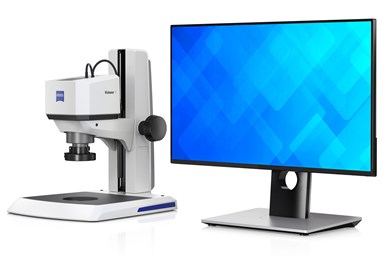Zeiss Digital Microscope Offers Extended Depth of Field
A Micro-mirror Array Lens System (MALS) simplifies the imaging and documentation process, enabling faster inspections and higher throughput.

Zeiss Visioner 1 digital microscope
The Zeiss Visioner 1 digital microscope enables all-in-one focus in real time thanks to its Micro-mirror Array Lens System (MALS). With an extended depth of field, users in manufacturing quality control and quality assurance can see the sample completely in focus without having to combine different focal planes from a series of images or postprocess them. This simplifies the imaging and documentation process, enabling faster inspections and higher throughput.
The Visioner 1 provides advanced depth of field in real time compared to conventional inspection systems, which are challenged by a shallow depth of field, especially at high magnification. The company says the MALS is a micro-electromechanical system (MEMS) consisting of a complex of small mirrors measuring 100 × 100 µm, which provide faster, more accurate measurements. The mirrors can be individually adjusted to generate "virtual" lenses with different curvatures and, thus, focusing planes. This enables the digital microscope to sharply image any point on the sample.
Users are able to adjust the micromirrors so quickly that the image display to the user is in real time. The result is 100 times greater extended depth of field than conventional digital microscopes. It also provides the ability to optically inspect for height differences of up to 69 mm without the need to move the optical system or refocus the sample. 3D information of the sample is visible at a glance, enabling faster and more reliable inspection.
The microscope also features ergonomic operation, fast visualization and documentation. For users, this creates tangible benefits in daily practice. The elimination of a tiring view through eyepieces and the manual readjustment of the microscope noticeably improves the work ergonomics. The real-time display of a fully sharp specimen on a screen also enables a healthier posture and better concentration on the actual inspection and documentation tasks.
Related Content
-
The Value of CMM Controller Retrofits
In this case, new controllers for two coordinate measuring machines — one 26 years old — with new programming software offers the possibility to enable multisensor inspection of critical, turned aerospace components.
-
The Advantages of Automated Shopfloor Gaging
This “parallel kinematic” gage offers the opportunity to automate and improve machining process control for shops endeavoring to move from sample inspection to 100% inspection.
-
How Well do You Know Granite Surface Plates?
Here are some tips for choosing, maintaining and customizing a granite solution that will best meet your shop’s particular inspection needs.







.jpg;maxWidth=300;quality=90)





